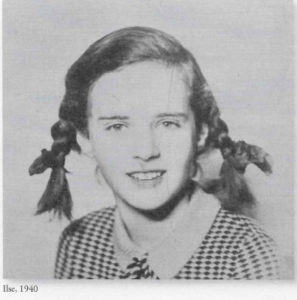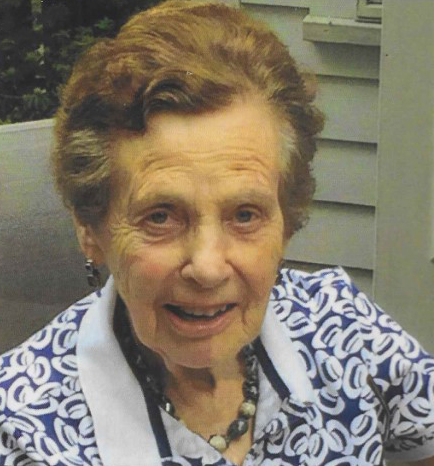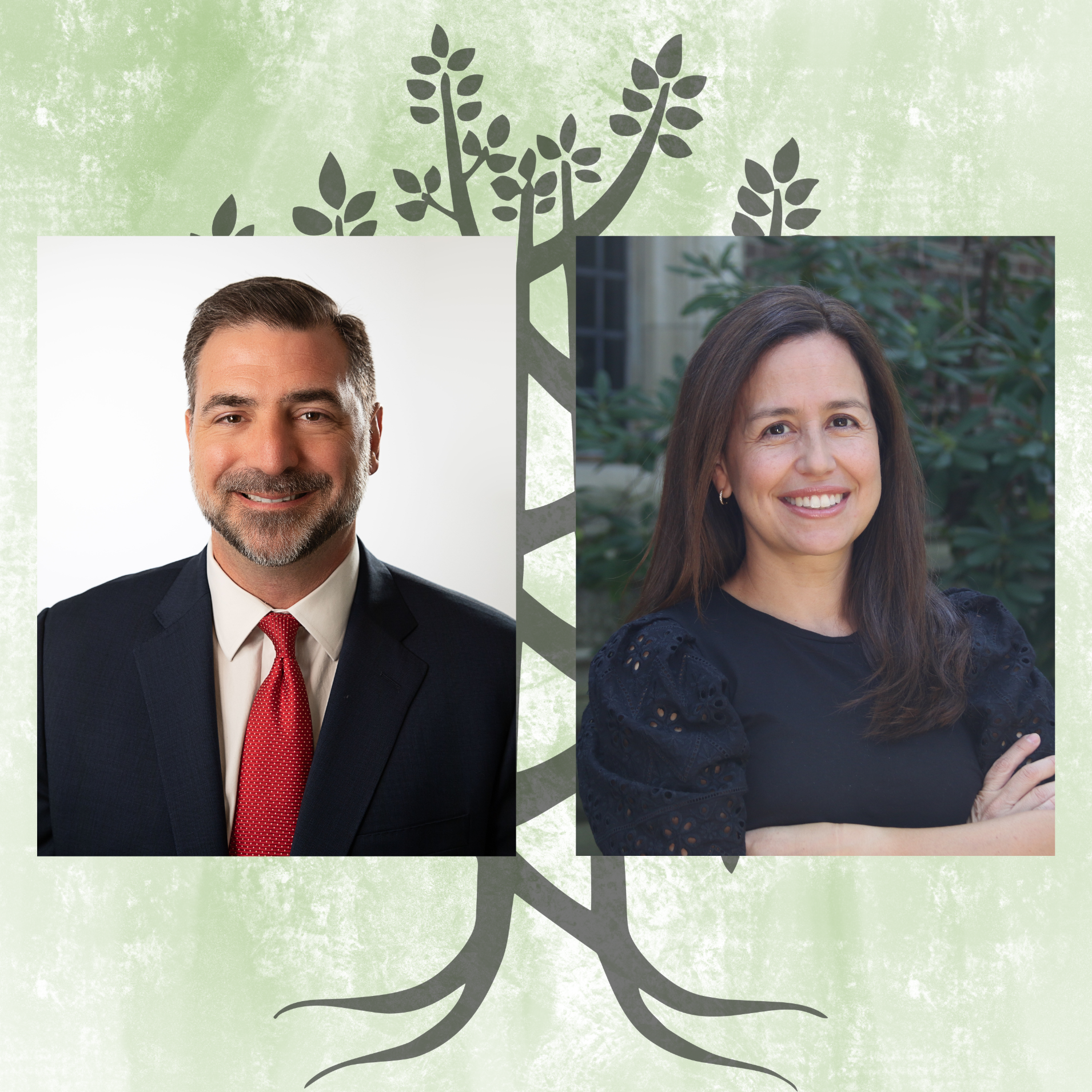
Ilse Leeser was born in Dortmund Germany. Her father, Alfred Jacobsohn was a Court of Appeals Judge in Hamm Germany. The Nazis came to power in 1933 and 2 years later Ilse’s father was informed that he could no longer practice law since he was Jewish.
When he was no longer permitted to practice law, the family moved to Cologne. Since her father had been a decorated WWI vet [he received the Iron Cross-one of Germany’s highest military distinctions], he received a full pension from the German government which provided financial support for the family. They were then able to live in Cologne with her father volunteering for a local Jewish social welfare agency.
Ilse was 10 years old when her father and 2 uncles were arrested, along with 30,000 other specific German Jews of influence and wealth, on Kristallnacht [Nov 9th 1938]. Her father and uncles were transported to Dachau, Buchenwald and Oranienburg. In order to obtain her husband’s release Ilse’s mother learned that they needed to leave Germany and had to have an affidavit from someone outside of Germany who would sponsor the family’s emigration. Her mom, Louise Jacobsohn contacted an old friend who had moved to Holland and obtained the affidavit. The agreement for release required that the family’s property was to be transferred to the “Aryans”. With the affidavit in place they were released in December 1938 and Ilse remembered the jubilant dinner on the day of their return home. They had shaven heads but were alive. Ilse’s uncles had received affidavits to emigrate, one to England, and the other to the United States.
[Nov 9th 1938]. Her father and uncles were transported to Dachau, Buchenwald and Oranienburg. In order to obtain her husband’s release Ilse’s mother learned that they needed to leave Germany and had to have an affidavit from someone outside of Germany who would sponsor the family’s emigration. Her mom, Louise Jacobsohn contacted an old friend who had moved to Holland and obtained the affidavit. The agreement for release required that the family’s property was to be transferred to the “Aryans”. With the affidavit in place they were released in December 1938 and Ilse remembered the jubilant dinner on the day of their return home. They had shaven heads but were alive. Ilse’s uncles had received affidavits to emigrate, one to England, and the other to the United States.
At age 11 Ilse and her sister were sent to Holland with the plan for her parents to soon follow once the transfer of assets to the Nazi regime was complete. Ilse and her sister lived with her mother’s old friend Sophie Hertz who was a German Jew who married a wealthy Jewish Dutch businessman. Ilse and her sister lived with the family in the Hague but the family was not warm or caring and Ilse felt that they did not show a lot of concern for the 2 young emigrants. The girls attended an English speaking school for the children of diplomats. After 1 ½ years the girls moved to Zutphen in the north of Holland with their mom’s cousin [referred to as Aunt Edith]. Shortly after moving to Aunt Edith and Uncle David’s house, Ilse’s parents were able to join them in Holland. Ilse’s parents came penniless as they had to leave all money and possessions in Germany. The family received financial support from a great uncle who was a successful businessman in London. Ilse’s parent’s plan was to emigrate to America. The family contacted the American Consulate in Holland to complete the paperwork. Ilse’s uncle who had left Germany in January 1940 was by then a successful medical doctor in the US and provided an affidavit of sponsorship. The family lived in a small house in Hilversum, near Amsterdam, as they waited for their visas to America. In May 1940 the German’s invaded Holland.
Soon after the German invasion Ilse’s father was arrested. Ilse’s aunt tried to convince her mother to send Ilse and her sister to England on the “Kindertransport” but her mother did not want the family separated. In January 1941 the Nazi occupation authorities mandated the registration of all Jews living in Holland. In April 1942 all Jews were required to wear the yellow star with black letters spelling “JOOD” [the Dutch word for Jew]. In the summer of 1942, the family was ordered to move to the Jewish Ghetto in Amsterdam. In the Ghetto the family lived in fear as each day community members were rounded up and deported by truck to an unknown location. It was at this time that Ilse’s parents made contact with the underground resistance organization. In March 1943, at age 15, Ilse and her sister were the first to leave to go “into hiding”. Sadly, when Ilse left the Ghetto it would be the last time she saw her parents.
The sisters were moved from one location to another a few days later. The 2nd home was that of Betsie and Kees Verhoevens. Betsie and Kees were part of the resistance and became the protectors of Ilse and her sister. The Verhoevens had been married for 4 years and had much to lose if they were caught hiding Jewish girls and thus they initially intended to only care for the girls for a brief time. After being there for 2 weeks Betsie and Kees agreed to keep the girls hidden until after the war. But after a short time Ilse’s sister opted to join the resistance and she left the Verhoevens’ home.
A few months into hiding Ilse learned that her father had been arrested just prior to her parents leaving to go into hiding. Ilse’s parents were sent to Vaught a Dutch concentration camp.
Ilse received fake documents and presented as Kees’s niece. She was accepted by the Verhoevens family but remained as secluded as possible so as not to be questioned. Ilse became worried as she had not heard from her sister. Betsie made a plan to deliver a letter to the head of the underground. When Betsie did not return as planned Kees moved Ilse to Betsie’s sister’s home and then to the rural north of Holland where she was hidden in multiple remote farms. After a year of hiding in the Friesland rural farm land area, Ilse was permitted to return to the loving home of Betsie and Kees. Upon return to the Verhoevens, Ilse learned that Bestie had a son name Wulgbold.
In the winter of 1945, Ilse had been hidden for 2 years and was 17 years of age. Her sister had married a co-member of the resistance and had a baby. That winter was remembered for severe hardship and a lack of food. Ilse would walk 20 miles per day for 10 days in a row to go from door to door of farmhouses bargaining for food in trade for personal possessions. At the end of the war in May 1945, Dutch farmer’s cupboards were filled with linen, clothes, dishes, and other items while people from cities or towns without farms were starving or malnourished.
On May 5, 1945 their town was liberated by Canadian soldiers. In the weeks that followed low flying Allied planes dropped food packages to the towns people. Ilse continued to live with Betsie and Kees and made contact with her relatives in London and the United States.
Ilse felt the need to gain some independence and she moved by herself to the Hague. Ilse got a job in a Department store. She and her sister remained hopeful that her parents were alive and had survived the war, but they soon received communication from the International Red Cross that their parents had been killed on May 21, 1943 in Sobibor, Poland. In April of 1947, after living in the Hague for 2 years, Ilse and her sister Eva received visas to emigrate to the United States. The sisters flew from Amsterdam to Gothenburg Sweden and then boarded a boat and traveled to New York. Ilse lived in New York with her aunt and uncle and made plans to attend High School. She wanted to be a doctor but her uncle suggested that an emigrant without financial means would not be able to get into medical school and that she should study nursing.
Ilse found her new life in America to be challenging. She worked at a department store while going to school. She wanted to “make up” for the lost teen years but found that was not possible. Ilse completed high school and did enroll in nursing school. While in nursing school, in 1949 she met Ralph Leeser. He was also an immigrant from Germany and had come to America in 1939, immediately after Kristallnacht, which he had witnessed. He entered the US Army in WW2 in 1943 (age 18) and served as a translator in the infantry. In Germany he once participated in the liberation of a concentration camp.
Upon graduation from nursing school Ilse married Ralph in 1951. Ralph finished college at NYU and then graduated from Brooklyn Law School. Ilse completed two MS degrees as well as her PhD in nursing research.
Ilse and Ralph lived in New York and later in New Jersey. Ilse remained in contact with Betsie and valued their life-long friendship. Betsie attended all of Ilse and Ralph’s children’s B’nai Mitzvot.
Ilse was tough, a survivor who was resilient and an optimist. Her daughter Miriam reflected that she was positive and even with all of her life’s challenges felt that she had a good life. She raised her children as reformed Jews. She felt it important to get an education as no one could take that away. Ilse and her husband did not like to spend money on tangibles.
While Ilse had refused to ever return to Germany, Miriam has been there and has looked into archives to pursue the family’s history. Miriam also did get to meet Betsie herself in Utrecht and on Betsie’s several visits to America.
Ilse is remembered by her daughter, Miriam, as a most compassionate person who wanted to help others.
Miriam wanted her children to have a Jewish identity, she moved to Wellesley in 1995 and joinwd TBE.
Ilse wanted people to know what happened to the Jews during WWII. She was worried of survivor’s bias as we don’t have the stories of those who didn’t make it. Ilse felt that the atrocities of WWII were the result of the Nazis and not the result of the Germans. She documented her history in the Shoah Project an authored a memoir entitled “Surviving the Holocaust” that was published in 2017 and can be found on the United States Holocaust Memorial Museum’s website here.


